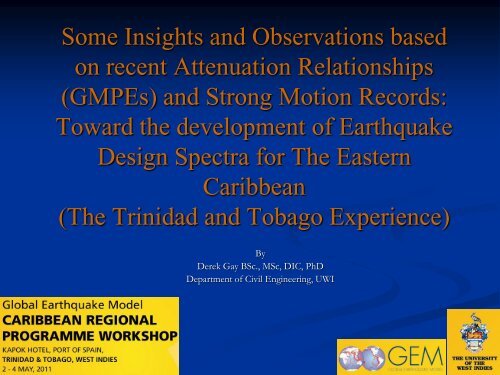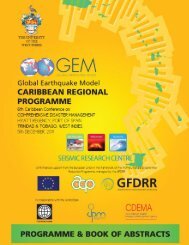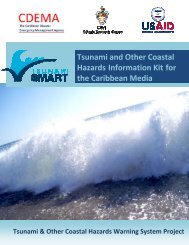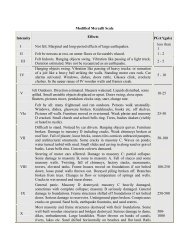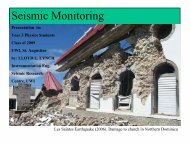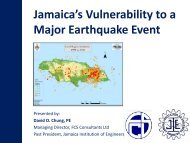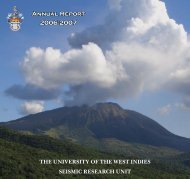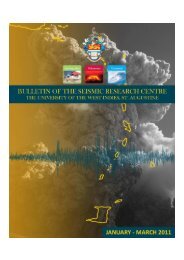Derek Gay
Derek Gay
Derek Gay
Create successful ePaper yourself
Turn your PDF publications into a flip-book with our unique Google optimized e-Paper software.
Some Insights and Observations based<br />
on recent Attenuation Relationships<br />
(GMPEs) and Strong Motion Records:<br />
Toward the development of Earthquake<br />
Design Spectra for The Eastern<br />
Caribbean<br />
(The Trinidad and Tobago Experience)<br />
By<br />
<strong>Derek</strong> <strong>Gay</strong> BSc., MSc, DIC, PhD<br />
Department of Civil Engineering, UWI
EUCentre 2010 PSHA Eastern Caribbean<br />
UHS-Trinidad (Port of Spain)<br />
2.00<br />
1.75<br />
1.50<br />
RP=95 years<br />
RP=475 years<br />
1.25<br />
SA(g)<br />
1.00<br />
RP=975 years<br />
RP=2475 years<br />
0.75<br />
0.50<br />
0.25<br />
0.00<br />
0 0.2 0.4 0.6 0.8 1 1.2 1.4 1.6 1.8 2 2.2 2.4 2.6 2.8 3<br />
T (s)
Douglas 2010, Consistency of ground-motion predictions from the past four decades
Douglas 2010, Consistency of ground-motion<br />
predictions from the past four decades<br />
“It is found that there are still considerable<br />
differences in predicted ground motions from<br />
the various GMPEs and that the variation<br />
between estimates is not reducing although the<br />
ground motion estimated by averaging median<br />
predictions is roughly constant in use<br />
worldwide.”
Douglas and Mohais 2009, Comparing predicted and observed<br />
ground motions from Subduction earthquakes in the Lesser Antilles<br />
• In total, over 300 records from 22<br />
earthquakes from various seismic networks<br />
are used within the analysis.<br />
• It is found that most of the GMPEs tested<br />
perform poorly, which is mainly due to a<br />
larger variability in the observed ground<br />
motions than predicted by the GMPEs,<br />
• Although, two recent GMPEs derived<br />
using Japanese strong-motion data provide<br />
reasonably good predictions.”<br />
• Kanno et al. 2006, Zhao et al. 2006“
NGA Spectra 2010
Zhao et al. 2006
Kanno et al. 2006
Kanno et al. 2006
Kanno et al. 2006
Conclusion <br />
• John Shepherd (2000-2004) could have been<br />
right!<br />
• It is possible to obtain Ss (0.2 sec) and S1 (1.0<br />
sec ) spectral accelerations to be very similar in a<br />
Subduction Zone.<br />
• Need to develop appropriate spectral method<br />
development or abandon the method and go to<br />
the area free methods of Woo and Frankel.
Strong Motion Accelograms: Tohoku Earthquake Japan; 2011-03-11<br />
Dominant Periods 1.5 – 2.0 secs
Strong Motion Accelograms: Tohoku Earthquake Japan; 2011-03-11<br />
Dominant Periods 2.0 – 2.5 secs
Strong Motion Accelograms: Tohoku Earthquake Japan; 2011-03-11<br />
Dominant Period 2.5 secs
Strong Motion Accelograms: Tohoku Earthquake Japan; 2011-03-11<br />
Dominant Period 2.5 secs
Site Effects: Modal Frequencies and the<br />
likelihood of Resonance


